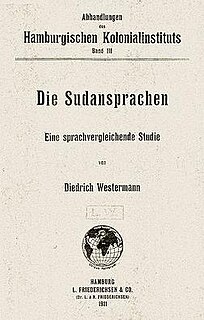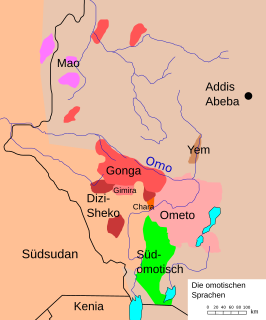Related Research Articles

Diedrich Hermann Westermann was a German missionary, Africanist, and linguist. He substantially extended and revised the work of Carl Meinhof, his teacher, although he rejected some of Meinhof's theories only implicitly. Westermann is seen as one of the founders of modern African linguistics.

The Khoisan languages are a group of African languages originally classified together by Joseph Greenberg. Khoisan languages share click consonants and do not belong to other African language families. For much of the 20th century, they were thought to be genealogically related to each other, but this is no longer accepted. They are now held to comprise three distinct language families and two language isolates.

The Omotic languages are a group of languages spoken in southwestern Ethiopia, in the Omo River region. The Ge'ez script is used to write some of the Omotic languages, the Latin script for some others. They are fairly agglutinative and have complex tonal systems. The languages have around 6.2 million speakers. The group is generally classified as belonging to the Afroasiatic language family, but this is disputed by some.

The West Atlantic languages of West Africa are a major subgroup of the Niger–Congo languages.

Benue–Congo is a major branch of the Volta-Congo languages which covers most of Sub-Saharan Africa.

The Mande languages are spoken in several countries in West Africa by the Mandé peoples and include Maninka, Mandinka, Soninke, Bambara, Kpelle, Dioula, Bozo, Mende, Susu, and Vai. There are "60 to 75 languages spoken by 30 to 40 million people", chiefly in Burkina Faso, Mali, Senegal, the Gambia, Guinea, Guinea-Bissau, Sierra Leone, Liberia, and Ivory Coast, and also in northwestern Nigeria and northern Benin.
The Southern Nilotic languages are spoken mainly in western Kenya and northern Tanzania. They form a division of the larger Nilotic language family, along with the Western Nilotic languages and the Eastern Nilotic languages.

The Atlantic–Congo languages are the largest demonstrated family of languages in Africa. They have characteristic noun class systems and form the core of the Niger–Congo family hypothesis. They comprise all of Niger–Congo apart from Mande, Dogon, Ijoid, Siamou, Kru, the Katla and Rashad languages, and perhaps some or all of the Ubangian languages. Mukarovsky's West-Nigritic corresponded roughly to modern Atlantic–Congo.
The Khoi languages are the largest of the non-Bantu language families indigenous to Southern Africa. They were once considered to be a branch of a Khoisan language family, and were known as Central Khoisan in that scenario. Though Khoisan is now rejected as a family, the name is retained as a term of convenience.
The Savannas languages, also known as Gur–Adamawa or Adamawa–Gur, is a branch of the Niger–Congo languages that includes Greenberg's Gur and Adamawa–Ubangui families.
The North Omotic (Nomotic) or Ta-Ne Omotic languages, belong to the Omotic branch of the Afro-Asiatic family and are spoken in Ethiopia.
The dozen Ngbaka languages are a family of Ubangian languages spoken in the Central African Republic and neighboring areas. It includes Pygmy languages such as Baka and Gundi. The most populous Ngbaka languages are Mbaka in the western branch, spoken by a quarter million people, and Mayogo in the eastern branch, spoken by half that number.
The Ngbandi language is a dialect continuum of the Ubangian family spoken by a half-million or so people in the Democratic Republic of Congo and in the Central African Republic. It is primarily spoken by the Ngbandi people, which included the dictator of what was then known as Zaire, Mobutu Sese Seko.
Lunguda (Nʋngʋra) is a Niger–Congo language of Nigeria. They settle western part of Gongola mainly in and around the hills of the volcanic Lunguda Plateau, Adamawa state. Joseph Greenberg counted it as a distinct branch, G10, of the Adamawa family. When Blench (2008) broke up Adamawa, Lunguda was made a branch of the Bambukic languages.
The Mumuye–Yendang languages are a proposed group of Savanna languages spoken in eastern Nigeria. They were labeled "G5" in Joseph Greenberg's Adamawa language-family proposal.

The Jukunoid languages are a branch of the Benue-Congo languages spoken by the Jukun and related peoples of Nigeria and Cameroon. They are distributed mostly throughout Taraba State, Nigeria and surrounding regions.
Tusya, also spelled Tusiã, Tusian, Toussian and also known as Wín, is a language or languages of Burkina Faso that is of uncertain affiliation within Niger-Congo. It was formerly linked with the Gur languages.
Nalu is an Atlantic language of Guinea and Guinea-Bissau, spoken by the Nalu people, a West African people who settled the region before the arrival of the Mandinka in the 14th or 15th centuries. It is spoken predominantly by adults. It is estimated to be spoken by a range of 10,000 to 25,000 people, whereas Wilson (2007) reports that there are around 12,000 speakers. It is considered an endangered language due to its dwindling population of speakers.
Ma, also known as A-Ma-Lo, Amadi, Madi, Madyo, is a Ubangian language spoken in Haut-Uele Province, the Democratic Republic of Congo.
Franz Rottland was a German linguist and Africanist.
References
- 1 2 Pasch, Helma (1986). Die Mba-Sprachen: Die Nominalklassensysteme und die genetische Gliederung einer Gruppe von Ubangi-Sprachen. Sprache und Geschichte in Afrika (SUGIA) (in German). Vol. Suplement 6. Köln: Rüdiger Köppe. p. 359. ISSN 0720-0986.
- ↑ Güldemann, Tom (2018). "Historical linguistics and genealogical language classification in Africa". In Güldemann, Tom (ed.). The Languages and Linguistics of Africa. The World of Linguistics series. Vol. 11. Berlin: De Gruyter Mouton. pp. 58–444. doi:10.1515/9783110421668-002. ISBN 978-3-11-042606-9. S2CID 133888593.